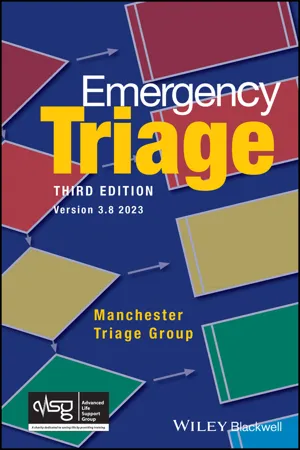
Emergency Triage
Manchester Triage Group
- English
- ePUB (mobile friendly)
- Available on iOS & Android
Emergency Triage
Manchester Triage Group
About this book
The Manchester Triage System (MTS) is the most widely used triage system in the UK, Europe and Australia, with tens of millions of patients being processed through hospital emergency departments. It is also used in hospitals throughout Brazil.
Emergency Triage is the core text for the MTS, which utilises a risk averse system of prioritisation for patients in all unscheduled care settings. As such, it is an essential text for all emergency department staff using the MTS, in particular triage nurses. The book is both a training tool and a reference for daily use in the Emergency Department and prehospital settings.
This edition features revised protocols that reflect new approaches to prioritisation, with accompanying revised flowcharts - the core part of the book.
Table of Contents
Presentation flow charts index
1: Introduction
2: The decision-making process and triage
3: The triage method
4: Pain assessment as part of the triage process
5: Patient management, triage and the triage nurse
6: Auditing the triage process
7: Telephone triage
8: Beyond prioritisation to other applications
This Edition was updated in 2023 to Version 3.8.
Frequently asked questions
- Essential is ideal for learners and professionals who enjoy exploring a wide range of subjects. Access the Essential Library with 800,000+ trusted titles and best-sellers across business, personal growth, and the humanities. Includes unlimited reading time and Standard Read Aloud voice.
- Complete: Perfect for advanced learners and researchers needing full, unrestricted access. Unlock 1.4M+ books across hundreds of subjects, including academic and specialized titles. The Complete Plan also includes advanced features like Premium Read Aloud and Research Assistant.
Please note we cannot support devices running on iOS 13 and Android 7 or earlier. Learn more about using the app.
Information
CHAPTER 1
Introduction
Background
- Development of the common nomenclature
- Development of common definitions
- Development of a robust triage methodology
- Development of a training package
- Development of an audit guide for triage
Nomenclature and definitions
| Hospital 1 | Hospital 2 | Hospital 3 | Hospital 4 | ||||
| Red | 0 | A | 0 | Immediate | 0 | 1 | 0 |
| Amber | <15 | B | <10 | Urgent | 5–10 | 2 | <10 |
| C | <60 | Semi-urgent | 30–60 | ||||
| Green | <120 | D | <120 | ||||
| Blue | <240 | E | – | Delay acceptable | – | 3 | – |
| FGHI | |||||||
| Priority | Max. time (minutes) | |||
| 1 | 0 | 0 | 0 | 0 |
| 2 | <15 | <10 | 5–10 | <10 |
| 3 | <60 | 30–60 | ||
| 4 | 120 | <120 | ||
| 5 | <240 | – | – | – |
| Number | Name | Colour | Max. time (minutes) |
| 1 | Immediate | Red | 0 |
| 2 | Very urgent | Orange | 10 |
| 3 | Urgent | Yellow | 60 |
| 4 | Standard | Green | 120 |
| 5 | Non-urgent | Blue | 240 |
Triage methodology
Table of contents
- Cover
- Table of Contents
- Title Page
- Copyright Page
- Editors
- Members of the original Manchester Triage Group
- International Reference Group
- Preface to the third edition
- Preface to the first edition
- CHAPTER 1: Introduction
- CHAPTER 2: The decision-making process and triage
- CHAPTER 3: The triage method
- CHAPTER 4: Pain assessment as part of the triage process
- CHAPTER 5: Patient management, triage and the triage practitioner
- CHAPTER 6: Auditing the triage process
- CHAPTER 7: Telephone triage
- CHAPTER 8: Beyond prioritisation
- Presentational flow chart index
- Presentational flow charts
- Discriminator dictionary
- Index
- End User License Agreement